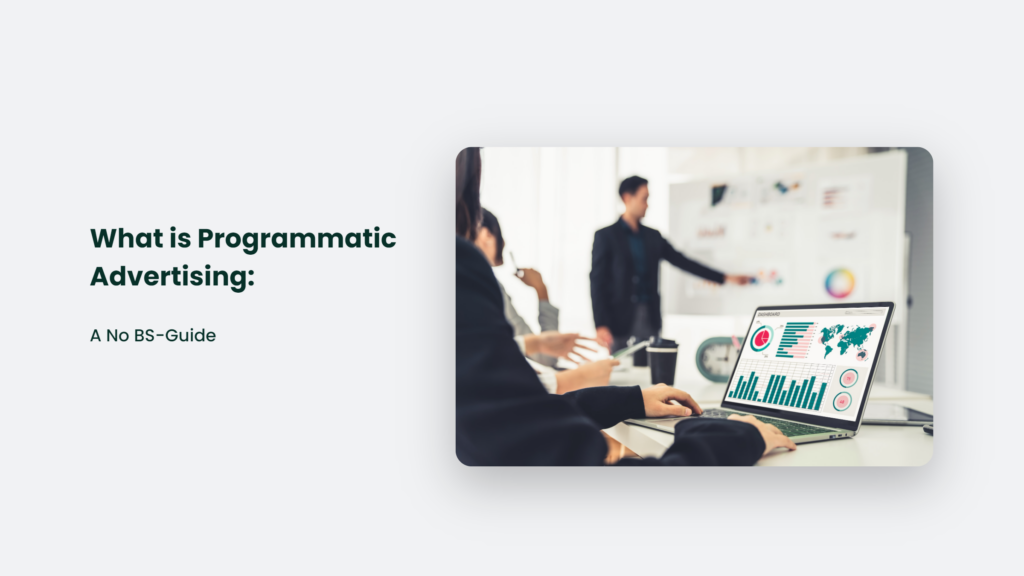

What is Programmatic Advertising: A No BS-Guide

As Seen On
Let’s cut the crap and get right to it: Programmatic advertising uses software and algorithms to automate buying and selling digital advertising. Instead of having actual humans negotiate prices and placements for ads, programmatic advertising relies on machines and math to get ads in front of the right eyeballs.
I know, thrilling stuff.
But as boring as it sounds on the surface, programmatic advertising has completely changed the game regarding marketing.
And any business not taking advantage of it is basically lighting their ad budget on fire.
So, in this post, I will explain in simple terms what is programmatic advertising, how it works, and why you need to be using it if you want to survive in today’s digital world.

What is Programmatic Advertising?
In the old days of advertising, buying ads was incredibly tedious and manual. Advertisers must call up publishers directly, negotiate prices and ad placements, and manually traffick creatives.
It was about as efficient as travel agents booking flights before the internet.
Programmatic advertising fixes all that by using software and algorithms to automate ad buying and selling:
- Advertisers use demand-side platforms (DSPs) to set targeting parameters, budgets, and goals for their ad campaigns.
- Publishers make their ad inventory available for sale through supply-side platforms (SSPs).
- Data exchanges match users’ browsing behaviour, location, demographics, interests, and more to the target parameters set by advertisers.
- When a user visits a website, an auction happens in milliseconds for the ad impression and the winning ad is automatically displayed.
So, instead of involving actual humans, the software automatically handles this entire process. Advertisers reach their perfect users, publishers monetize their sites, and users see relevant ads. It’s a digital marketing utopia (that is if digital marketing utopias actually existed).
The result is advertising that is faster, smarter, and more efficient for everyone involved.
Well, almost everyone. More on that later.
How Programmatic Advertising Works
To understand why programmatic advertising is so powerful, you must understand how it works behind the scenes.
Here’s a quick rundown of what’s happening:
Advertisers Set Up Campaigns
Advertisers (or their agencies) use demand-side platforms (DSPs) to set up and manage their programmatic ad campaigns. It includes defining their target audience, setting budgets, uploading creatives, and configuring bidding strategies.
For example, a retailer might set up a campaign targeting women 25-35 interested in fashion with a max bid of $5 CPM.
Publishers Make Inventory Available
At the same time, publishers use supply-side platforms (SSPs) to make their ad inventory available for sale. Ad inventory refers to all the spots on a website or app where ads can be placed.
Publishers connect their SSPs to ad exchanges, facilitating buying and selling inventory through auctions.
Ad Exchanges Connect Buyers and Sellers
Ad exchanges use data and algorithms to match advertisers’ campaign parameters with available ad inventory. When a user visits a site, an auction determines which ad will be shown based on factors like bid price and relevance.
It all happens automatically in milliseconds without any humans involved.
Winning Ad is Served
The ad exchange conducts an auction for each ad impression, and the winning bidder’s ad is automatically displayed to the user. The advertiser only pays when the user sees the ad.
Advertisers can monitor performance in real time and make changes to optimize results. Publishers get paid for each impression.
The Benefits of Programmatic Advertising
Programmatic advertising provides several unique benefits compared to traditional manual ad buying:
Precision Targeting
With programmatic advertising, you can target users based on demographics, interests, behaviours, location, and more. Combining first and third-party data allows you to reach your perfect customers like never before.
Real-Time Optimization
You can monitor the performance of your programmatic campaigns in real time and make adjustments on the fly. See what’s working and double down on it. Stop wasting money on what’s not.
Increased Efficiency
Programmatic advertising automates the busy work, freeing you up to focus on strategy and creativity. No more wasting hours on the phone haggling over ad rates.
Better ROI
With laser-targeted ads and constant optimization, programmatic provides a better return on your ad spend. You only pay when a real user actually sees your ad.
Omnichannel Reach
Programmatic advertising makes it easy to run campaigns across devices, platforms, and formats, including desktop, mobile, video, social, native, audio, and more.
Programmatic Advertising in Action
To see how programmatic advertising works in the real world, let’s look at an example:
Sarah owns an online boutique selling handmade jewellery. She wants to promote her earrings to drive more sales.
Here’s how Sarah can leverage programmatic advertising:
First, Sarah would work with a DSP to set up a campaign targeted at women 30-50 interested in fashion and jewellery. She would define a budget and configure her ads and bidding strategy.
When women fitting that criteria visit websites, Sarah’s ads would automatically be entered into auctions to show on those sites. Her ads would be displayed on sites relevant to her target audience.
Sarah could monitor the performance in real-time, pausing poorly performing sites and increasing bids on better-performing placements. She only pays when her ad is shown.
By optimizing over time, Sarah ensures her ads and products are shown to women most likely to buy her earrings. Programmatic provides a level of precision not possible with traditional advertising.
The Problem with Programmatic Advertising
Of course, no digital marketing innovation comes without its downsides. And programmatic advertising is no exception.
Here are a few of the biggest issues to be aware of:
Limited Transparency
While you can target users precisely, you often don’t know exactly where your ads will be shown. It can lead to ads appearing on shady sites or content you don’t want to be associated with.
Ad Fraud
The massive scale of programmatic advertising has led to widespread fraud: bots and other schemes prey on the automated nature of programmatic.
Slow Mobile Pages
Too many ads competing in auctions can bog down mobile sites and frustrate users. Ads render last, so they often load slowly.
Irrelevant Ads
Programmatic algorithms sometimes get it right. You may end up paying to show ads to people who have no interest in your product.
Privacy Issues
Programmatic advertising depends on user data for targeting. However, people need to be more relaxed about how their data is collected and used. Regulation is also ramping up.
The key is finding the right balance between leveraging programmatic capabilities and mitigating the drawbacks through brand safety measures, whitelisting, and optimizing for actual ROI.
Frequently Asked Questions:
How does programmatic advertising work?
Advertisers use demand-side platforms to set campaign parameters. Publishers make inventory available via supply-side platforms. Ad exchanges connect the two sides via real-time auctions to determine which ads to serve.
What are the benefits of programmatic?
Benefits include laser-targeted ads based on robust data, constant optimization of campaigns, improved ROI, and omnichannel distribution across platforms.
Who uses programmatic advertising?
Programmatic advertising is used by brands and agencies across all industries including retail, CPG, finance, technology, entertainment, and more. Any company marketing online can benefit from programmatic.
The Bottom Line on Programmatic Advertising
Programmatic advertising isn’t perfect. But when used properly, it provides unmatched efficiency, precision, and results regarding digital advertising.
For most businesses, the question is no longer whether to use programmatic advertising but how to use it most effectively. Implemented correctly, it can greatly amplify your marketing efforts.
So don’t let the technical jargon scare you. Programmatic advertising is nothing to fear. Look at it as an opportunity to take your advertising to the next level. The competition is definitely using it.
Programmatic advertising is simply using technology to improve an outdated process. And that’s something every business can benefit from, no matter what you sell.
So embrace the machines. Let math be your guide. Programmatic advertising is the future whether you like it or not.
Konger
Up until working with Casey, we had only had poor to mediocre experiences outsourcing work to agencies. Casey & the team at CJ&CO are the exception to the rule.
Communication was beyond great, his understanding of our vision was phenomenal, and instead of needing babysitting like the other agencies we worked with, he was not only completely dependable but also gave us sound suggestions on how to get better results, at the risk of us not needing him for the initial job we requested (absolute gem).
This has truly been the first time we worked with someone outside of our business that quickly grasped our vision, and that I could completely forget about and would still deliver above expectations.
I honestly can't wait to work in many more projects together!
Disclaimer
*The information this blog provides is for general informational purposes only and is not intended as financial or professional advice. The information may not reflect current developments and may be changed or updated without notice. Any opinions expressed on this blog are the author’s own and do not necessarily reflect the views of the author’s employer or any other organization. You should not act or rely on any information contained in this blog without first seeking the advice of a professional. No representation or warranty, express or implied, is made as to the accuracy or completeness of the information contained in this blog. The author and affiliated parties assume no liability for any errors or omissions.

